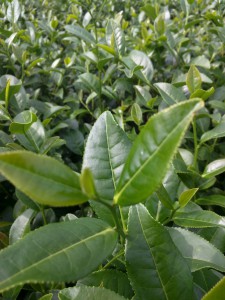
the above photo is was taken at San Jing Gardens, one of the main providers of Oolong tea to my store. The important thing to take note of is that the leaf that farmer Li is holding between his fingers is unhealthy in comparison to the other leaves on the tree.
here is a comparison:

These leaves are healthier and fuller.
One problem that comes up in tea harvesting on many farms is that both healthy and unhealthy leaves are taken and mixed into the same batches of tea. There are two major reasons why it is better not to take the unhealthy leaves from the tree.
1: unhealthy leaves don’t taste as good as healthy leaves. They are usually more astringent, bitter, and have less perfume than fully developed, healthier leaves.
2: an unhealthy leaf means that that section of the tree is experiencing a minor health problem. This is the same is with our own bodies. If you were to break your toe, you would be careful about walking until it healed, and most people certainly wouldn’t go and run a marathon. A slightly unhealthy leaf on a tea tree, if allowed to develop by itself will ultimately fall away to be replaced by better growth eventually. If farmers harvest all the leaves indiscriminately, then it means that the trees have no chance to get healthy on their own, and are exposed to a massive shock.
This is one of the main reasons why hand harvesting of tea is more sustainable than machine harvesting. Machine harvesting takes all of the leaves from the tree, meaning it can’t grow big and healthy, and most machine harvested tea fields die within a decade, having to be left fallow for a certain period of time until the soil recovers.
Hand harvested tea, and tea fields which have sustainable hand harvesting practices, such as those of San Jing farms, end up with healthier trees that can be used for the entire life of the tree, which can be much longer than a human life.
Unfortunately, not many farmers are doing this type of ecologically sustainable farming, and instead go for large yields and what is sacrificed in quality and tree life is made up in profit and short term gain.
People like Li Minghan of San Jing farms are tea production pioneers, because they are combining the newest research into sustainable agriculture with traditional tea farming and processing techniques to create an entirely new genre of bio tea, which is healthy, delicious, and good for the local environment.
That is why Chayo Tea cooperates with Li and others like him, in order to bring more good into the world, one cup at a time.